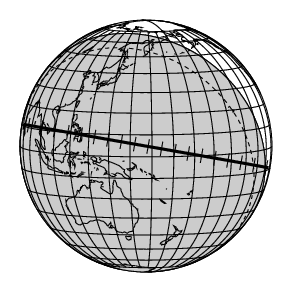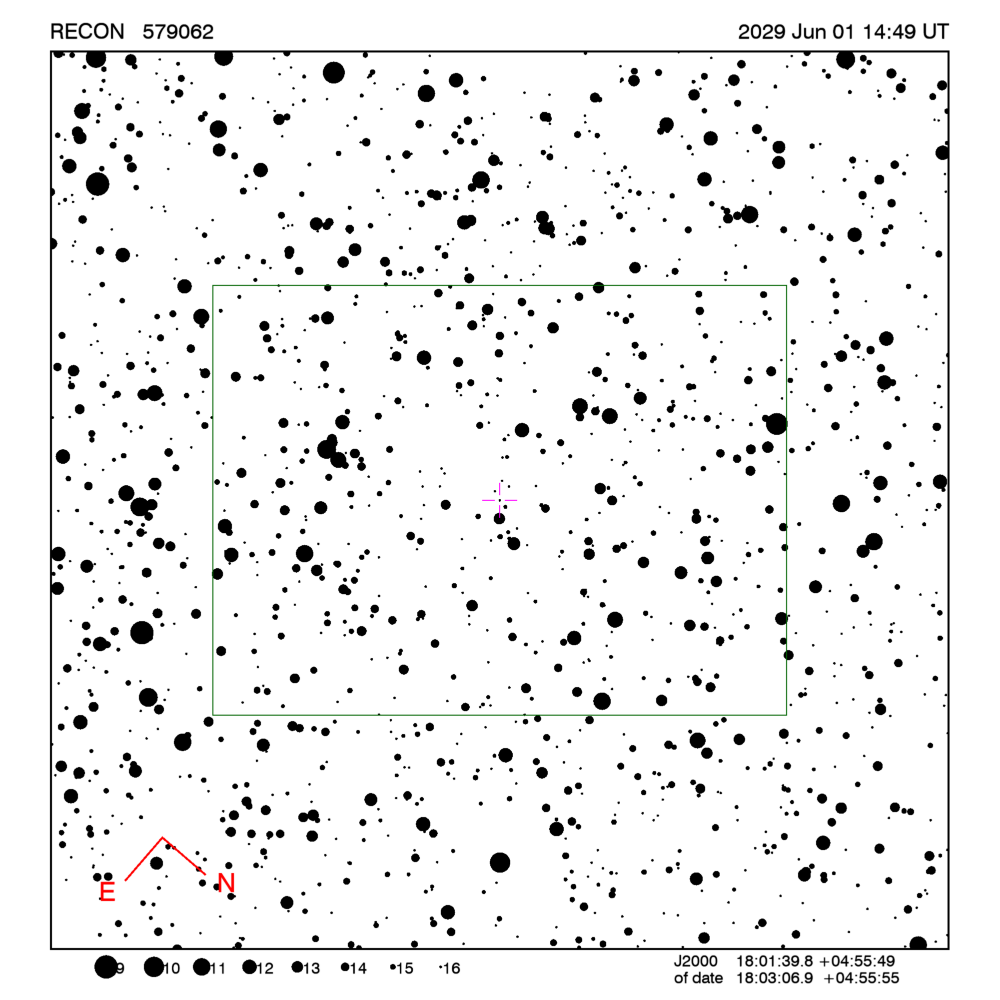RECON: TNO occultation with 579062
Event between (579062) 14KF113 and star GA0940:06179871
with event index number of 2783531
Geocentric closest approach at 2029/06/01 14:51:03 UTC
J2000 position of star is 18:01:39.8 +04:55:49
Equinox of date position of star is 18:02:49.9 +04:55:54
Stellar brightness G=16.7,
use SENSEUP=128 with the MallinCam and and exposure
time of 2 seconds with the QHY174 camera.
Star is 48 degrees from the moon.
Moon is 73% illuminated.
Apparent brightness V=22.4
 Object is 35.1 AU from the Sun
and 34.3 AU from the Earth.
Object is 35.1 AU from the Sun
and 34.3 AU from the Earth.
Apparent velocity is 22.5
km/sec on the sky relative to the star, or,
3.3 arcsec/hr.
The 1-sigma error in the time of the event is 346 seconds.
The 1-sigma cross-track error in the shadow position is
2086 km.
The object has an absolute magnitude Hv=6.9
Diameter=250.0 km assuming a 5% albedo -- 11.2 sec chord
Diameter=102.1 km assuming a 30% albedo -- 4.6 sec chord
Dynamical classification is SCATEXTD
Star training set for 579062, (2029/06/01 14:49UT)
Object RA Dec mag sep mel
Vega 18:37:56.0 +38:48:43 0.0 34.79 62
60Bet Oph 17:44:55.6 +04:33:25 2.8 4.55 52
66 Oph 18:01:43.2 +04:22:10 4.6 0.66 48
PPM 164939 18:00:31.2 +04:57:16 8.0 0.65 49
PPM 165023 18:03:09.8 +04:40:47 9.9 0.25 48
PPM 165040 18:03:46.7 +04:50:29 11.6 0.19 48
579062 18:03:06.9 +04:55:55 16.7 48
Positions are for equinox of date

Azimuth is measured in degrees eastward from north.
North is at an azimuth of 0, due East is at an azimuth
of 90 degrees, due South is 180, and due West is 270.
Do not use the listing below for the RECON CPC 1100 telescopes.
This is provided for other non-team facilities.
Star training set for 579062, (2029/06/01 14:49UT)
Object RA Dec mag sep mel
Vega 18:36:56.7 +38:47:08 0.0 34.79 62
60Bet Oph 17:43:28.3 +04:34:06 2.8 4.55 52
66 Oph 18:00:15.8 +04:22:07 4.6 0.66 48
PPM 164939 17:59:04.1 +04:57:17 8.0 0.65 49
PPM 165023 18:01:42.6 +04:40:41 9.9 0.25 48
PPM 165040 18:02:19.6 +04:50:21 11.6 0.19 48
579062 18:01:39.8 +04:55:49 16.7 48
Positions are for J2000
Event circumstances last updated at 2023/08/31 02:51:34 UT
Marc W. Buie,
Southwest Research Institute
RECON
 Object is 35.1 AU from the Sun
and 34.3 AU from the Earth.
Object is 35.1 AU from the Sun
and 34.3 AU from the Earth.
